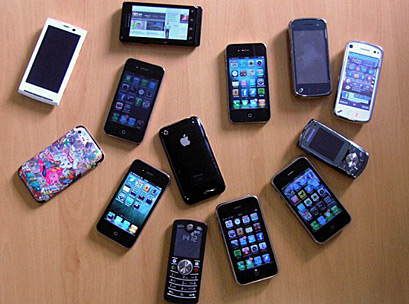Driven by increased demand from developed regions for high-end models, along with an unexpectedly strong push from emerging economies for lower-cost products, smartphones are expected to account for the majority of global cellphone shipments in 2013 – two years earlier than previously predicted.
Smartphone shipments in 2013 are forecasted to account for 54 per cent of the total cellphone market, up from 46 per cent in 2012 and 35 per cent in 2011, according to information and analytics provider IHS. The year 2013 will mark the first time that smartphones will make up more than half of all cellphone shipments.
“This represents a major upgrade for the outlook compared to a year ago, when smartphones weren’t expected to take the lead until 2015,” said Wayne Lam, senior analyst for wireless communications at IHS.
“Over the past 12 months, smartphones have fallen in price, and a wider variety of models have become available, spurring sales of both low-end smartphones in regions like Asia-Pacific, as well as midrange to high-end phones in the US and Europe.”
Lam added that the solid expansion in both shipments and market share this year of smartphones will make them the leading type of mobile phone for the first time, and shipment growth in the double digits will continue for the next few years.
By 2016, smartphones will represent 67.4 per cent of the total cellphone market.
Feature phone finale
While still accounting for less than 50 per cent of the market this year, smartphones will become the single largest cellphone segment by the end of 2012, surpassing feature phones.
The rise of smartphones means a fall from grace for ‘feature phones’, which are a grade above the most basic, low-cost entry-level phones but lack the sophisticated engineering and functionality of smartphones. Feature phones commanded the wireless market as late as last year with a 46 per cent market share, but their share will decrease to 41 per cent this year, setting a trend of irreversible decline and progressive weakening in their numbers.
By 2016, feature phones will be confined to a market share of 28 per cent – less than half the share of smartphones by that time.
A third type of phone, the entry-level and ultra-low-cost handset, will occupy the bottom tier of the market with approximately 14 per cent share this year and end up with just 4.2 per cent share by 2016.
As smartphones become ever more popular and affordable, they will become the focal point of the handset industry, IHS believes.
The growth of the mobile applications development industry, which turns out numerous applications on a variety of smartphone platforms, will also help maintain the continuing importance of the smartphone segment.
The smartphone market comprises two segments – the midrange to high-end smartphone and the low-end class. Already, manufacturers are introducing affordable low-end smartphones equipped with lower memory densities and a more limited feature set into developing countries and emerging markets, encouraging the use of data plans, which drive greater revenue. Low-end smartphone users will likely be first-time smartphone consumers, and will represent 43 per cent of the total smartphone market by 2016.
In comparison, the midrange to high-end smartphone segment consists of users in the developed countries or in the more industrialised urban areas of some developing nations. This group of smartphone users will continue to outnumber their low-end smartphone counterparts, with more than 700 million midrange to high-end smartphone users forecast by 2016.
Apple and Google, now the two leading smartphone platforms, are the leaders in the space.
The intense competition in smartphone platforms has resulted in a few casualties, including Symbian from Nokia and WebOS from Palm. No longer will hardware capabilities be the sole determinant of success for smartphones moving forward, IHS believes. Factors including software capability, a sleek and intuitive user interface, the variety of available applications, strong support from the developer community, and the strength and seamlessness of vertical integration will help influence purchasing decisions.
Samsung of South Korea became the overall worldwide leader in handsets during the first quarter, displacing Nokia of Finland, which had occupied the top spot for well over a decade and is now ranked second.
US-based Apple, China’s ZTE and South Korea’s LG Electronics rounded out the top five, accounting for 75.5 per cent of all handset shipments – not just smartphones – during the first quarter, up marginally from 74.7 per cent in the fourth quarter last year.
GB






